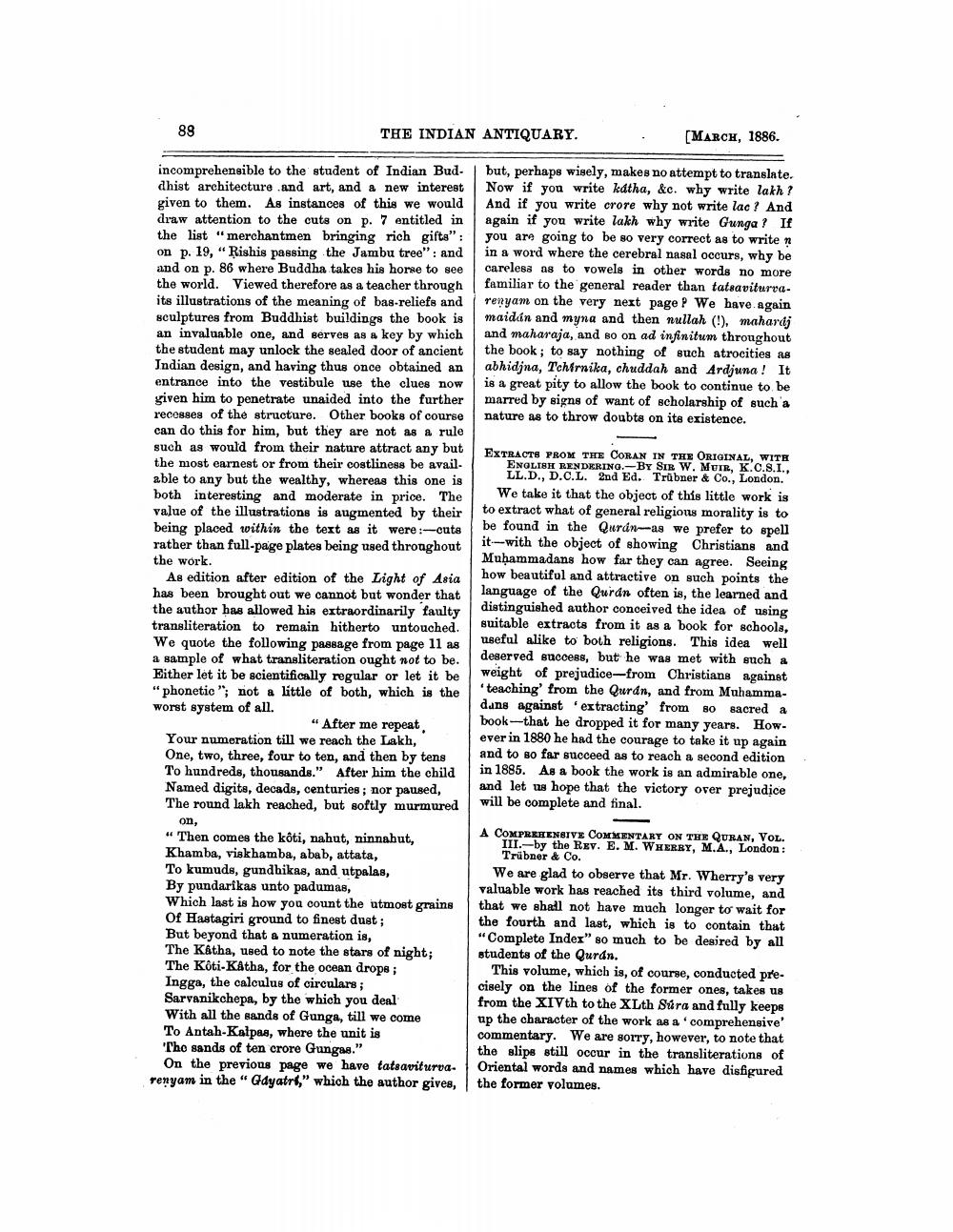________________
88
THE INDIAN ANTIQUARY.
.
[MARCH, 1886.
but, perhaps wisely, makes no attempt to translate. Now if you write katha, &c. why write lakh ? And if you write crore why not write lac ? And again if you write lakh why write Gunga ? If you are going to be so very correct as to write n in a word where the cerebral nasal occurs, why be careless as to vowels in other words no more familiar to the general reader than tatsaviturva. renyam on the very next page P We have again maidin and myna and then nullah (!), mahardj and maharaja, and so on ad infinitum throughout the book; to say nothing of such atrocities as abhidjna, Tchirnika, chuddah and Ardjuna! It is a great pity to allow the book to continue to be marred by signs of want of scholarship of such a nature as to throw doubts on its existence.
incomprehensible to the student of Indian Bud- dhist architecture and art, and a new interest given to them. As instances of this we would draw attention to the cuts on p. 7 entitled in the list "merchantmen bringing rich gifta" : on p. 19, "Rishis passing the Jambu tree": and and on p. 86 where Buddha takes his horse to see the world. Viewed therefore as a teacher through its illustrations of the meaning of bas-reliefs and sculptures from Buddhist buildings the book is an invaluable one, and serves as a key by which the student may unlock the sealed door of ancient Indian design, and having thus once obtained an entrance into the vestibule use the clues now viven him to penetrate unaided into the further recesses of the structure. Other books of course can do this for him, but they are not as a rule such as would from their nature attract any but the most earnest or from their costliness be avail. able to any but the wealthy, whereas this one is both interesting and moderate in price. The value of the illustrations is augmented by their being placed within the text as it were :-cuts rather than full-page plates being used throughout the work.
As edition after edition of the Light of Asia has been brought out we cannot but wonder that the author has allowed his extraordinarily faulty transliteration to remain hitherto untouched. We quote the following passage from page 11 as a sample of what transliteration ought not to be. Either let it be scientifically regular or let it be "phonetic "; not a little of both, which is the worst system of all.
"After me repeat Your numeration till we reach the Lakh, One, two, three, four to ten, and then by tens To hundreds, thousands." After him the child Named digits, decade, centuries; nor paused, The round lakh reached, but softly murmured
on, " Then comes the kôti, nahut, ninnahut, Khamba, viskhamba, abab, attata, To kumuds, gundhikas, and utpalas, By pundarikas unto padumas, Which last is how you count the utmost grains Of Hastagiri ground to finest dust; But beyond that a numeration is, The Katha, used to note the stars of night; The Koti-Katha, for the ocean drops; Ingga, the calculus of circulars; Sarvanikchepa, by the which you deal With all the sands of Gunga, till we come To Antah-Kalpas, where the unit is 'Tho sands of ten crore Ghungas."
On the previous page we have tatsaviturvarenyam in the "Gdyatry," which the author gives,
EXTRACTS PROM THE CORAN IN THE ORIGINAL. WITH
ENGLISH RENDERING.-BY SIR W. MUIR, K.C.S.I.
LL.D., D.C.L. 2nd Ed. Trübner & Co., London. We take it that the object of this little work is to extract what of general religions morality is to be found in the Quran-as we prefer to spell it--with the object of showing Christians and Muhammadans how far they can agree. Seeing how beautiful and attractive on such points the language of the Quran often is, the learned and distinguished author conceived the idea of using suitable extracts from it as a book for schools, useful alike to both religions. This idea well deserved success, but he was met with such a weight of prejudice-from Christians against "teaching' from the Quran, and from Muhammadans against 'extracting' from 80 sacred a book--that be dropped it for many years. How. ever in 1880 he had the courage to take it up again and to so far succeed as to reach a second edition in 1885. As a book the work is an admirable one, and let us hope that the victory over prejudice will be complete and final.
A COMPREHENSIVE COMMENTARY ON THE QURAN, VOL.
III.-by the Rev. E.M. WHERRY, M.A., London: Trübner & Co. We are glad to observe that Mr. Wherry's very valuable work has reached its third volume, and that we shall not have much longer to wait for the fourth and last, which is to contain that "Complete Index" so much to be desired by all students of the Quran.
This volume, which is, of course, conducted precisely on the lines of the former ones, takes us from the XIVth to the XLth Súra and fully keeps up the character of the work as a comprehensive commentary. We are sorry, however, to note that the slipe still occur in the transliterations of Oriental words and names which have disfigured the former volumes.




